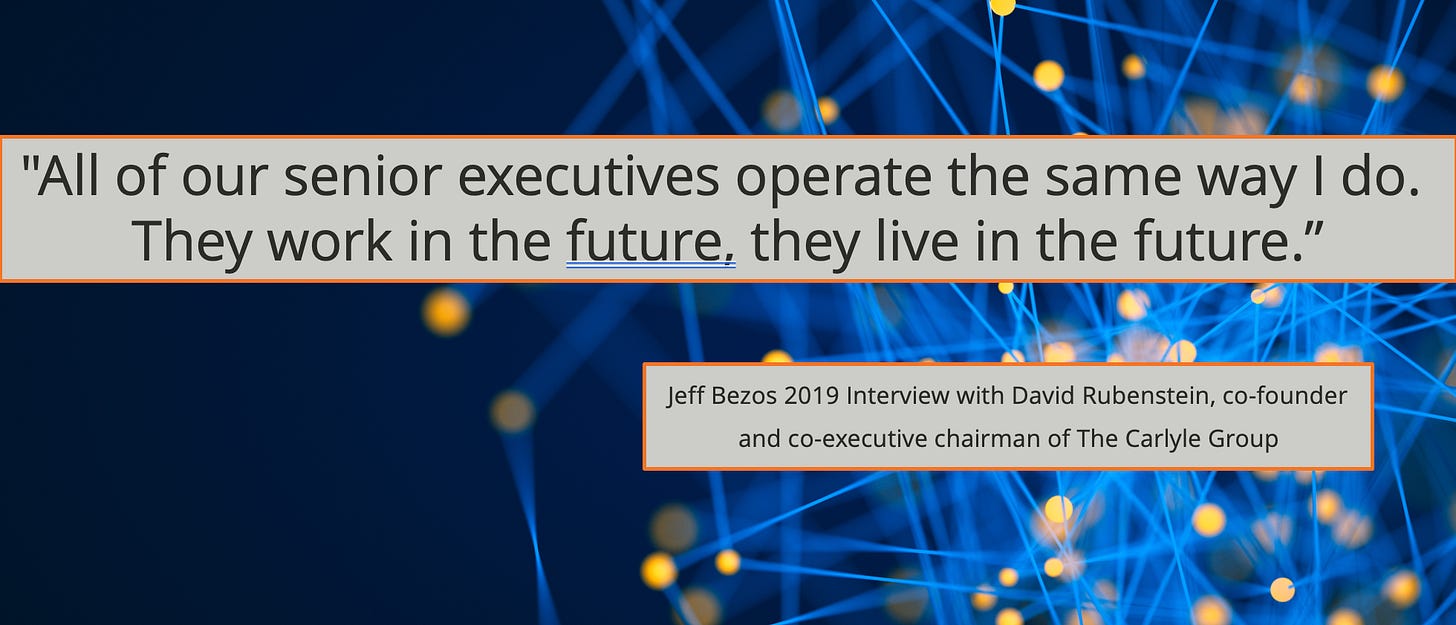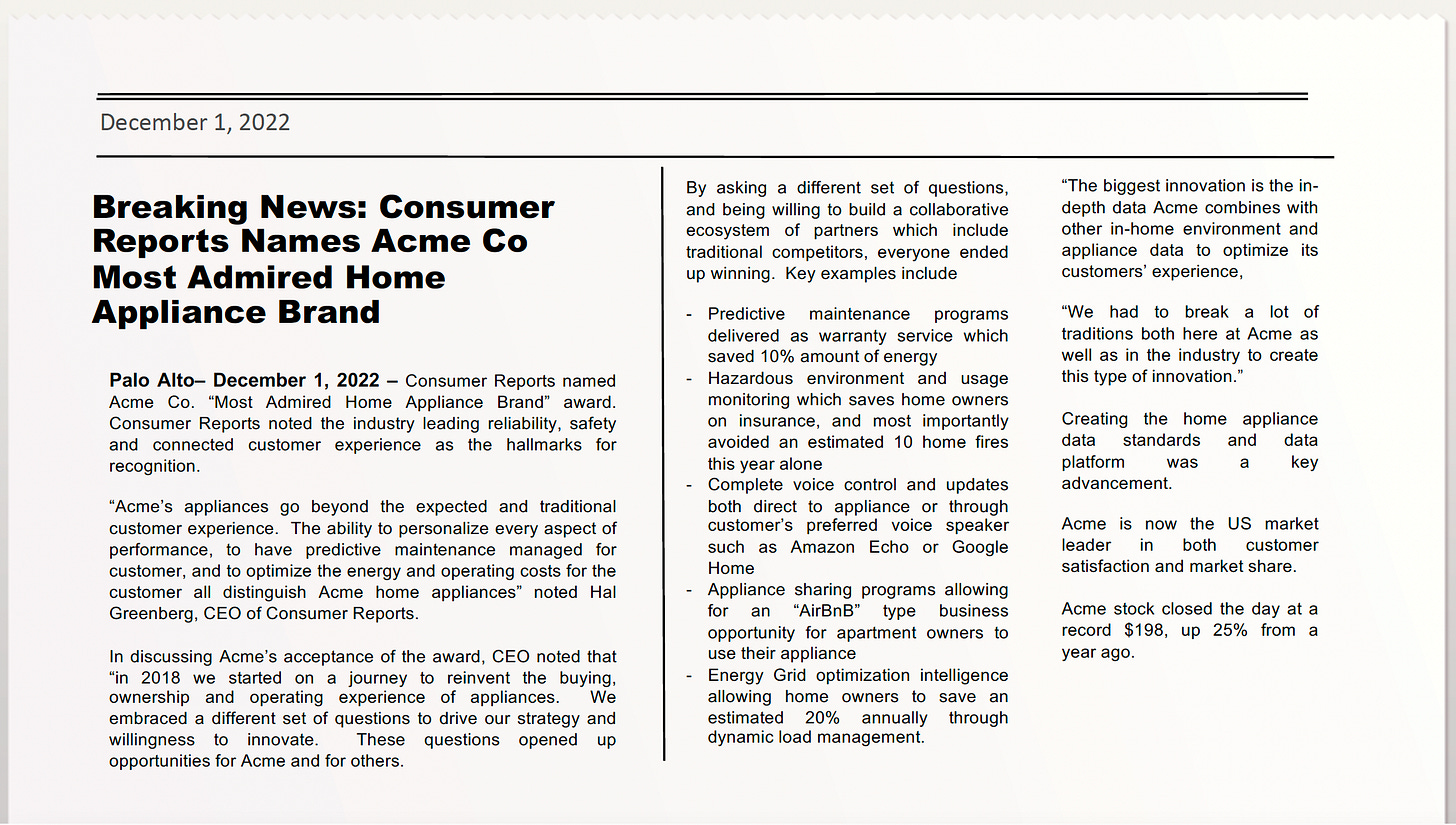The Digital Leader Newsletter — Strategies and Techniques for Change Agents, Strategists, and Innovators.
The future ain’t what it used to be.
—Yogi Berra
When it comes to innovation, there is rarely a straight line from “A” to “B”. Why is that? In general, we usually create only a vague sketch of the goal we’re trying to achieve. As a result, we tend to revise the goal as we go, a process that costs time, money, and, sometimes, the project’s very success. We all have various definitions of the goal.
But what if you could see into the future and accurately visualize your end product before launching a project? Sound good? Well, there’s really nothing stopping you. At Amazon, they do it every day. It’s an exercise in clarity they call the future press release. Not only can it define the future,, but it can also keep your organizational structure from transforming into a bureaucratic rat’s nest and empower a leader to drive the initiative across multiple teams.
IMAGINE THE FUTURE
Most innovation and change initiatives take work and true ownership from multiple teams and leaders. While long-form narratives are great for developing a deep understanding, sometimes a brief, more impactful approach is necessary to excite and engage a wider range of parties.
Jeff Bezos is famous for requiring teams to create the future press release before launching a new product, undergoing any transformation, or entering a new market. The process of creating a simple but specific product announcement clarifies the original vision. It acts as a forcing function to thoroughly examine key features, adoption, and your project’s likely path to success. Committing to a press release, speculative though it may be, also helps leadership clearly express to important stakeholders the road map to success.
THE RULES FOR THE FUTURE PRESS RELEASE
The future press release creates energy, captures ideas, and forces choices. It defines clear and lofty goals, requirements, and objectives and to building broad understanding from the start of a program or enterprise change. They always take iterations,, and I often write different versions to highlight options and subtle differences between choices.
Here are the “rules” of the future press release to help in your use:
Rule 1. The goal must be stated at a future point where success has been achieved and realized. Press releases discussing the launch are good, but a better one is sometime after launch, where true success can be discussed.
Rule 2. Start with the customer. Use the press release to explain why the product is important to customers (or other key stakeholders). How did the customers’ experience improve? Why do the customers care? What delights customers about this new service? Then discuss other reasons it was important and key goals. These customer examples and value propositions need to communicate the differentiated customer experience or super-power. What’s the critical differentiating capability we are giving a customer? Why will customers choose this solution?
Rule 3. Set an audacious and clear goal. Articulate clear, measurable results you’ve achieved, including financial, operating, and market share results.
Rule 4. Outline the principles used that led to success. This is the trickiest and most important aspect of the future press release. Identify the hard things accomplished, the important decisions, and the design principles that resulted in success. Discuss the issues that need to be addressed to achieve success. Getting the “tricky” issues on the table early on helps everyone understand the real nature of the change needed. Don’t worry about how to solve these issues yet. You’ve still got time to figure that out.
THE FORCING FUNCTION
Once you’ve created a future press release, the project leader needs to be empowered to make these changes happen. Focus on creating a future press release–oriented communication plan helping the project leader find success across the organization.
Remember, the future press release is a forcing function. Once the press release is reviewed and approved, teams should have a challenging time backing out of the commitments they have made. A leader can refer to parts of the press release and use it to remind and hold teams accountable. It paints a clear vision to galvanize understanding and commitment. It is a contract.
Here is an example of a future press release. Notice how the lead paragraph clearly states the objective. In this case, “Consumer Reports gave Acme Co. its ‘Most Admired Home Appliance Brand’ award.” Once the aspirational goal and time limit are set, the future press release clarifies why the award was presented and illustrates how Acme Co. started by asking a different set of questions and being willing to build and collaborate within an ecosystem of partners, including traditional competitors. It concludes with a series of specific milestones that the organization can use as a road map from here to there.
Back to Digital Transformation
In last week’s newsletter, I discussed that companies need to stop suffering from poor returns on their digital transformation strategies and in order to do so, the important “first steps” were to define a “what if” portfolio of scenarios giving crisp definition to what “transformation” might really be. The future press release technique is one way of articulating these “what if” scenarios.
If you’d like to discuss this technique, just let me know! Send me an email info@rossmanpartners.com
Please share this newsletter with your peers.
Onward!
John
About The Digital Leader Newsletter
This is a newsletter for change agents, strategists, and innovators. The Digital Leader Newsletter is a weekly coaching session focusing on customer-centricity, innovation, and strategy. We deliver practical theory, examples, tools, and techniques to help you build better strategies, better plans, better solutions — but most of all, to think and communicate better.





